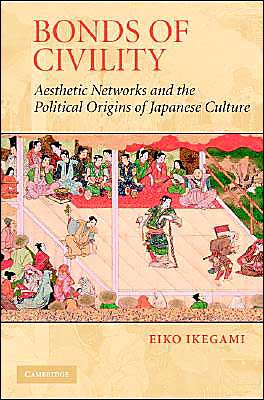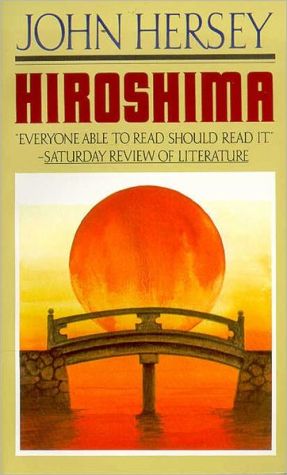Bonds of Civility: Aesthetic Networks and the Political Origins of Japanese Culture
In this book, Eiko Ikegami uncovers a complex history of social life in which aesthetic images become central to Japan's cultural identities. Combining sociological insights on organizations with prodigious scholarship on cultural history, this book explores such wide-ranging topics as the central role of networks in performing arts, tea ceremony and haiku, the politics of kimono aesthetics, the rise of commercial publishing, the popularization of etiquette and manners, the vogue of androgyny...
Search in google:
Combines sociological insights in organizations with cultural history.
\ Cambridge University Press\ 0521809428 - Bonds of Civility - Aesthetic Networks and the Political Origins of Japanese Culture - by Eiko Ikegami\ Excerpt\ \ \ \ \ Section One\ A Social Theory of State, Civility,\ and Publics\ \ \ \ \ \ \ Introduction\ Aesthetic Japan and the Tokugawa Network Revolution\ \ \ \ In 1969, a thin, elderly novelist with eagle eyes made an important presentation in Stockholm. The official Nobel Prize lecture given by Kawabata Yasunari, the first Japanese novelist to win the Nobel Prize in Literature, was titled "Japan, the Beautiful and Myself." Sounding the depth of human feeling elicited by the poetic beauty of snow, moon, and blossom, he declared his personal solidarity with the Japanese aesthetic tradition. Kawabata's lecture was a singularly powerful representation of Japan's cultural identity in aesthetic terms. Two and a half decades later, the novelist Oe Kenzaburo, Japan's second Nobel laureate in literature, delivered a provocative critique of Kawabata from the same podium. His Nobel lecture had a challenging title: "Japan, the Ambiguous and Myself." Oe implied that Japan's uncritical celebration of its aesthetic traditions had resulted in the overvaluation of an ambiguous mode of communication that proved to have strongly negative consequences for modern Japanese democracy - this cultivation of ambiguity in the last analysis represents a distrust of rational linguistic articulation as a means of communication.\ I cite these two Nobel laureates' views on "Japan and the beautiful" not to adjudicate their views but rather to use their words as pointers to the presence of unsettling cultural questions. Their critical exchange at one of the most prestigious public forums in the world reminds us of the political significance of Japanese aesthetic culture. This book does not explain their views, but I focus on an element that is missing in their discussions. I place their questions in historical context by presenting a detailed survey of the social history of an aesthetic - namely, how the people of Japan actually incorporated the world of the beautiful within their social lives. There were many individuals, both professionals and very serious amateur artists, who loved to share the world of beauty. To that end, they formed incredibly robust and vibrant networks with the sole goal of practicing traditional forms of Japanese arts and poetry. I maintain that the history of the ways in which people develop their aesthetic lives in close connection with their cultures of sociability offers a key to deciphering the social complexities of the Japanese world of beauty. Consequently, this book examines the historical process through which aesthetic socializing became a central component of pre-modern Japanese civility and associational life.\ Although the realm of the beautiful is usually understood as separate from the political arena, this notion does not necessarily hold true for every society. Japan offers us a case in point. The pre-modern Japanese approach to poetry and other arts stands in sharp contrast to the modern notion of artistic and literary appreciation as produced primarily by isolated individuals in private studios or studies. The greater part of artistic and literary endeavors in pre-modern Japan consisted of group activities in which the participants were at once producers and recipients of aesthetic productions. This reflects the fact that Japanese people appreciated the interactive process of creating an art through an intense emotional rapture of synergy at the site of production. In other words, the Japanese artistic and poetic traditions were highly social as well as intensely aesthetic.\ One curious aspect of tracing the history of Japanese organizational experiments is that one finds the Japanese search for horizontal and voluntary social associations intersecting at a number of points with the cultivation of beauty. The arts and poetry associations began to organize people into networks that extended beyond their immediate territorial and status affiliations. The most critical element of this pattern of artistic production was the formation of a common spatial/cognitive sphere for aesthetic socialization among the participants - the sphere that I will call the aesthetic public. These sites of aesthetic appreciation constituted enclaves of free socialization in which people could temporarily suspend the application of feudal norms. By forming connections among people from different economic and status backgrounds, the art and poetry circles and associations of early modern Japan began to play roles functionally similar to those of civic networks in Western political history. In fact, I have found that a focus on the social dimension of aesthetic life in early modern Japan offers a new perspective on the relationships among the distinctive trajectories of Japanese state formation, associational politics, and the emergence of nationwide market networks.\ Consequently, this book is about politics as well as aesthetics. The analysis that follows presents a sociological examination of the transformation of Japanese aesthetic cultures and its unexpected role in the invention of Japanese styles of civility and cultural identities. A closer look at the history of Japan indicates that aesthetic patterns of socializing have been closely intertwined with the political and associational life of the Japanese people. For this reason, an investigation into aesthetic socialization offers a telescopic view of historical discoveries that goes well beyond the realm of the aesthetic alone.\ Contemporary Japanese, as well as outside observers, often associate Japan with distinctive aesthetic traditions in the arts and literature. From local goodwill volunteers in the Rotary clubs who receive foreign visitors with the tea ceremony and flower arrangements to Kawabata's Nobel Prize lecture, contemporary Japanese draw on this image continually when they are required to introduce their country to outsiders. It is not only on the level of cultural identities and images that one can still encounter some distinctive cultural practices in contemporary Japan. For example, Ōoka Makoto, a poet and critic, has estimated that modern Japan probably has the highest density of amateur poets in the industrial world - in such traditional shorter forms of poetry as haiku and waka. The high level of enthusiasm for traditional forms of poetry is evident from the fact that almost all major Japanese popular newspapers have weekly poetry pages that usually feature winning poems selected from several thousand entries submitted each week by readers. And the association of the realm of the beautiful and Japan is so much taken for granted that it can be put to use for commercial purposes. One recent magazine advertisement that exploited this well-established cognitive association conveys the flavor of the present situation. The advertisement featured two forms of "the beautiful" on two facing pages. On the left-hand page is a picture of a woman bowing slightly in an elegant but dignified manner accompanied by copy that reads "Hito ga, utsukushi kuni" ("As people, we form a beautiful country"). The facing page has a picture of an automobile and Mount Fuji with the words "utsukushii kuni no merusedesu," which can be translated as "Mercedes fits the beautiful country" (Figure 0.1).\ These contemporary applications of the Japanese aesthetic tradition reflect the interplay among various contemporary actors with widely differing motivations and interests. At the same time, the image of Japan as a nation with a long history of aesthetic accomplishment has definite historical roots. This book sheds new light on one of these roots, namely the political and organizational origins of Japanese aesthetic culture. I maintain that this taken for granted aspect of Japanese cultural identities was invented and formulated through the dynamics of Japanese organizational developments. The study of the emergence of Japanese collective identity, in particular with regard to its evolution into a modern nation-state, requires an examination of historical contingencies. I examine a critical period in the genealogy of the rise of a Japanese aesthetic by focusing on the early modern era, the period of the Tokugawa shogunate (1603-1867).\ \ Figure 0.1. Japan the Beautiful. An advertisement based on Japan's reputation for beauty. On the left-hand page, a woman bowing, with the legend "Hito ga, utsukushi kuni " ("As people, we form a beautiful country"). On the facing page, an automobile and Mount Fuji with the words "utsukushii kuni no merusedesu," "Mercedes fits the beautiful country."\ Image not available in HTML version\ \ This book does not focus on any specific group or class of people. The aesthetic associations touched a variety of people in Japan, from emperors, warlords, samurai, merchants, and farmers to courtesans, outcasts, and other marginal groups of people. And it was these people who also continuously experimented with various ways of socializing with one another. The majority of individuals who appear in this book are undistinguished men and women who left barely identifiable traces on Japanese aesthetic and literary history. For example, there were lowly monks, warriors, and courtiers in the medieval period sitting excitedly together under the cherry blossoms, creating chains of verses. There were male and female amateur poets who traveled extensively across Japan and corresponded incessantly; their activities unintentionally produced a remarkable complex of private networks outside the control of the Tokugawa state. There were also samurai who enjoyed singing popular songs so much that they considered their artist identities within their music circles to be much more important than their formal feudal titles. There were also groups of people who exhibited a contentious solidarity against the established feudal order by showing off outlandish tastes in kimono fashion. Although these uses of aesthetic activities look quite different from one another, they have one thing in common. The people who were involved in aesthetic socialization had great capacities for networking across social barriers, and the multiplication of their network connections often yielded unexpected social results. When networks based on aesthetic activities intersected the rapidly expanding social, political, and economic networks of the Tokugawa period, a set of unforeseen complex social and cultural dynamics emerged in Japanese society.\ As I examined the transformation of Japanese associational life from the medieval to the early modern periods, I came to realize the importance of incorporating the notion of publics - the spheres of interactions where cultural activities take place - into sociological theories of cultural change and identity formation. As I use the term as a technical word, publics are communicative sites that emerge at the points of connection among social and/or cognitive networks. As I see it, identity, culture, and meanings as such are "emergent properties" arising from the interplay of human subjectivity in actors involved in network relationships at the communicative sites of publics. In this way, my sociological accounts of history take the social sites of interactions as focal points of analysis.\ Interestingly, pre-modern Japan developed a distinctive form of arts whose practices crystallized the importance of sites of gathering and the interactive process of artistic production. During the medieval period, a style of arts and literature that emphasized the importance of collaborative interactions emerged. This style of arts emphasizes interactions at a site of aesthetic production as the centerpiece of their aesthetic theories. Unlike an individualized modern notion of arts and literature, these arts took interactive processes as their most meaningful aspect. In these forms of performing arts, which some scholars called za (seated) arts and literature, the sites of aesthetic productions were consciously regarded as spaces distinct from the social order. This deliberate theorizing of the dynamics of collaborative synergy in spheres of interactions made this style of arts not only a distinctive aesthetic form but also an important means of sociability. A form of linked poetry known as renga and the tea ceremony most eloquently advocated the spirit of such aesthetic theories. The rise of the za arts represented the emergence of an important cultural resource in Japan. Although not all art forms in pre-modern Japan took a distinctively collective approach, an aesthetic ideal that considered the sites of art gatherings as free associational activities had a lasting influence on the social role of arts in general.\ \ The Tokugawa Popularization of Aesthetic Knowledge\ The rise of this distinctive aesthetic style alone would not have made aesthetic publics so central to Japanese social life. Politics played a significant role as well. To understand the process in which aesthetic publics became so important as sites of communicative activities, we have to step back to examine the history of Japanese social organizations. In particular, the distinctive relationship between two important factors, the trajectory of Japanese state development and the development of horizontally organized associations significantly influenced the social role of aesthetic publics. During the medieval period, the samurai warlords continuously fought each other while attempting to reorganize the social order based on the model of hierarchical samurai vassalage. However, unlike the popular image of feudal Japan, medieval Japan also experienced the development of political forces that organized people in relatively horizontal forms. The activities of various trade guilds (also called za), corporate villages, and a form of horizontal alliances called ikki were most vigorous during the medieval period. Although not political by nature, the aesthetic associational networks that developed during this period incorporated the same free spirit of horizontally organized associations. Eventually, however, at the end of centuries of struggles, it was the vertical reorganization of the samurai's national hierarchies that became a unifying principle for the early modern political order. To protect this order, the unifying rulers severely suppressed the political power of various social associations.\ The tension in the relationship between the state and associational networks influenced the structures and interrelationships of various communicative sites. Because the formation of horizontal associations was severely restricted under the Tokugawa shoguns, it was difficult to form active communicative sites of publics based on voluntary political alliances of people. At the same time, artistic networking became surprisingly vital as it was already an established method of civic sociability. Under the rules of Tokugawa shoguns, aesthetic publics became unofficial but valuable and lively sites of social interactions outside the formal hierarchical order of the state.\ The rise of aesthetic images of Japan was a path-dependent phenomenon formulated through successive phases of political and cultural developments since the ancient period. Clearly, the close association of beauty and political power did not enter Japanese history with the Tokugawa shogunate. Nor did the construction of Japanese cultural identities centering on aesthetic idioms originate in the early modern period. Some specific genres of high culture - which produced such masterpieces as "The Tale of Genji" and waka poetry - had flourished in the milieu of the ancient imperial court. And, as discussed earlier, the medieval period saw the emergence of various distinctive forms of performing arts and literature. Given all that, what role did the Tokugawa period play in the formation of aesthetic identities in Japanese society? During the pre-Tokugawa period, cultural resources of outstanding merit were still largely produced, patronized, and consumed by an elite circle of courtiers, priests, and higher-ranking samurai. Although medieval Japan developed a prototypical form of aesthetic socialization, the body of cultural knowledge rarely functioned as an imagined link with the space called Japan in the minds of the Japanese population at large.\ In contrast, the early modern period was a critical phase in Japanese cultural history because it witnessed the popularization of many elements of what we now consider Japanese traditions. Long before the rise of the contemporary nation-state, Japan was ruled by Tokugawa shoguns who officially upheld a policy of strict status distinctions and territorial segmentation. For the first time in history, a large portion of the Japanese population began to assume the existence of objective cultural standards that should be met by those aspiring to gentility. Socialization through the aesthetic circles became an important part of Tokugawa styles of civility. Furthermore, the book trade of the Tokugawa period supported a growing sense of symbolic community among the Japanese through the objectification of a collective consciousness, the accelerated formation of communication networks, and material additions to the fund of common knowledge. The fact that a plane of commonality evolved primarily within the realm of the beautiful in Tokugawa society, which was otherwise decentralized and divided, holds some suggestive implications for the post-Tokugawa development of the modern Japanese nation-state.\ Aesthetic practices in Tokugawa Japan had their roots in the ancient and medieval cultures that developed in and around the emperor's court in Kyoto. As a result, in the Tokugawa civilizing process, images of Japan were presented from the viewpoint of the supposed center, ancient court life, while Japan's periphery was neglected. The implied process of exclusion extended not only to the cultures of people living in territorial peripheries such as the Northern Uteri (Ainu) and people in Okinawa but also filtered out diverse cultural traditions of various marginal subpopulations. However, the story of the rise of aesthetic Japan was not that of a top-down enforcement of national solidarity. Tokugawa Japan was ruled by feudal rulers whose acute concern was to divide and subjugate the population. The rise of aesthetic Japan is also not simply the story of elite intellectuals who created a national myth. Rather, it was the accumulative effect of largely unplanned actions of originally unrelated people who began to network with each other. They did this in order to search for ways of socializing with each other and, in doing so, to trespass feudal boundaries and limitations. People explored horizontal and voluntary ways of associating and found genuine joy in immersing themselves into aesthetic group activities while thus escaping from the tedium and the constrictions of the hierarchical feudal state structures. Another force was comprised by the merchant-publishers, who were eager to popularize aesthetic knowledge for profit.\ Consequently, the central focus of this book is the fluid dynamics and unexpected consequences of what might be called "the Tokugawa network revolution." As I see it, a critical moment of cultural history in any society occurs when communicative networks suddenly expand in scale, density, and complexity. The resulting patterns of communication influence both the form and the content of the discourse conveyed through the networks. The kinds of cultural resources that are available at the time of network expansion will determine the range of content in the resulting cultural identities of that society. Thus, the extension of a society's communicative networks and the alteration of its cognitive maps are reciprocally influential.\ A network revolution can occur within a variety of social-structural circumstances and phases of development. Although a network revolution may appear to be a politically neutral organizational transformation, it never occurs in a power vacuum. Network multiplication is likelier to result from the unequal distribution of power among intersecting network systems. An example of such inequality would be the forceful incorporation of the political structure, economic system, and aesthetic standards of a suzerain state within the cultures of its colonial possessions. Another example of a rapid cognitive revision is a society's collective incorporation into the conceptual framework of a world religion. The power differential between the indigenous cognitive network and the external cultural force affects the formation of new associational maps, as do timing and socio-political contexts. Together with the available cultural resources and the structural patterns of emerging network relations, the effects of hegemonic power relations at the critical moment of rapid network multiplication are important influences on the new collective cultural identities of a people.\ It is in this sense that I consider that Tokugawa Japan arrived at a critical moment of cultural history at the time of its network revolution in the early modern period. To summarize my argument, I maintain that this revolution consisted of the simultaneous development of four kinds of social networks: (1) a phase of territorial state-making at the beginning of the seventeenth century involving the construction of decentralized but well-integrated political networks; (2) the formation of nationwide trade routes and commodities markets together with the remarkable growth of urban consumption centers; and (3) the development of such knowledge-based networks as aesthetic circles and associations. Furthermore, as derivative effects of the rise of the integrated state and nationwide market systems, there emerged (4) the development of infrastructures for communication networks, including improvements in sea and overland travel as well as commercial publishing. These four conditions of possibility provided the socio-economic backdrop for the vibrant informal spheres of civic cultures that emerged within Tokugawa society.\ \ \ \ \ © Cambridge University Press
Introduction : aesthetic Japan and the Tokugawa network revolution31Civility without civil society : a comparative overview192Culture and identity as emergent properties in networks443The medieval origin of aesthetic publics : linked poetry and the ritual logic of freedom764The late medieval transformation of Za arts in struggles between vertical and horizontal alliances1025Tokugawa sate formation and the transformation of aesthetic publics1276The rise of aesthetic civility1407The Haikai, network poetry : the politics of border crossing and subversion1718Poetry and protest : the rise of social power2049Tacit modes of communication and Japanese national identity22110Categorical protest from the floating world : fashion, state, and gender24511The information revolution : Japanese commercial publishing and styles of proto-modernity28612Hierarchial civility and beauty : etiquette and manners in Tokugawa manuals32413The rise of aesthetic Japan363Epilogue : toward a pluralistic view of communication styles380








